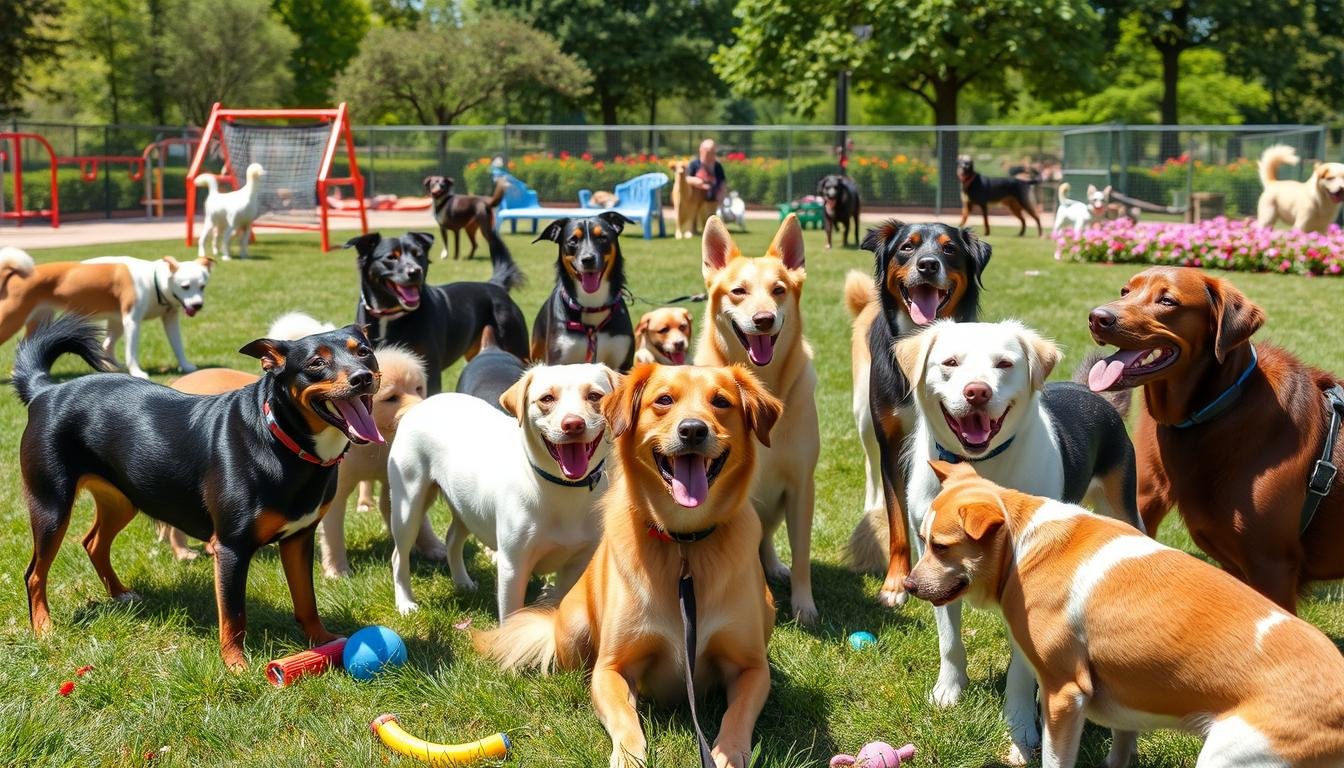20 Dog Socialization Tips for Raising Friendly and Confident Dogs
Ever wondered why some dogs seem to effortlessly navigate the world while others cower at the slightest noise? The secret lies in socialization, a key process that shapes a dog’s personality and behavior. As a dog owner, I’ve learned that proper socialization can make a big difference.
Socialization is more than just puppy playdates. It’s a way to expose dogs to various experiences. This helps them develop positive behaviors and coping skills. The socialization window for puppies is from 3 to 16 weeks of age, making this period critical for their development1. During this time, a puppy’s brain is like a sponge, ready to absorb new information and form lasting impressions.
But don’t worry if you’ve missed this window – it’s never too late to start socializing your dog. Whether you have a young pup or an adult rescue, these 20 dog socialization tips will guide you. We’ll cover all aspects of canine social etiquette, from managing dog park interactions to building trust with strangers.
Remember, socialization is an ongoing process that requires dedication, but the payoff is immense. A well-socialized dog is not only a joy to be around but also better equipped to handle life’s challenges. So, let’s dive into these expert tips and set your furry friend up for social success!
Key Takeaways:
- Socialization is key for developing positive behaviors in dogs
- The critical socialization window is from 3 to 16 weeks of age
- Proper socialization prevents behavior problems like fearfulness and aggression
- It’s never too late to start socializing your dog
- A well-socialized dog is happier, more confident, and easier to manage
Understanding the Critical Socialization Period
The critical socialization period is a key time in a dog’s life. It shapes their future behavior and social skills. Let’s explore what makes this stage so important.
The Importance of the 8-16 Week Window
Puppies are most open to new things between 8-16 weeks. This time is critical for their early socialization. Experts say puppies should meet 100 new people before they’re 12 weeks old2.
This early exposure helps prevent fear and aggression later. It’s a vital time for a puppy’s development.

Brain Development During Early Socialization
A dog’s behavior is 35% genetic and 65% shaped by socialization and care3. Early socialization greatly affects their brain. Puppies that experience a lot of stimuli tend to be more confident3.
| Socialization Period | Age Range | Key Focus |
|---|---|---|
| Curiosity Period | 5-7 weeks | Exploring surroundings |
| Behavioral Refinement | 7-9 weeks | Learning social cues |
| Fear Imprint | 8-11 weeks | Avoiding negative experiences |
| Environmental Awareness | 9-12 weeks | Exposure to various stimuli |
| Seniority Classification | 13-16 weeks | Establishing social hierarchy |
Setting Realistic Expectations
It’s good to aim for your puppy to meet 100 people, dogs, and experiences by 4 months4. This ensures they get a broad social experience. Remember, it’s not just about how many experiences, but the quality of those experiences.
By focusing on the critical socialization period, you’re setting your puppy up for success. Spend these early weeks wisely to have a well-adjusted dog for years to come.
Essential Dog Socialization Tips for Success
I’ve gathered some key dog socialization tips to help you raise a friendly and confident dog. These tips work for puppies and adult dogs alike. They’ll help you build your dog’s social skills.

1. Start early: The best time for puppy socialization is between 3 and 12 weeks old5. This early period is vital for shaping your puppy’s future interactions.
2. Expose gradually: Start by introducing your dog to quiet places. Then, move to busier areas. This gradual approach helps avoid overwhelming your pet.
3. Use positive reinforcement: Treats are great for encouraging good social behavior in dogs5. They help your dog associate new experiences with happiness.
4. Attend training classes: Dog training classes provide a safe space for socialization. They help your dog interact positively with other dogs and people5.
5. Diversify experiences: Introduce your dog to different types of people, like men, women, and children5. This variety is essential for your dog’s comfort around all people.
“Socialization is a lifelong process. Even adult and senior dogs can benefit from new experiences and interactions.”
Remember, adult dogs, including rescues, can greatly benefit from socialization6. Doggie daycare and boarding facilities offer supervised environments for socializing6. For senior dogs, short walks and gentle play with familiar faces are beneficial6.
| Age Group | Socialization Focus | Key Considerations |
|---|---|---|
| Puppies (3-12 weeks) | Various people, environments, experiences | Critical period for development |
| Adult Dogs | New experiences, supervised interactions | Gradual exposure, positive reinforcement |
| Senior Dogs | Gentle interactions, familiar faces | Short, comfortable socializing sessions |
By following these tips, you’ll be on your way to raising a well-adjusted, social dog. Remember, consistency and patience are key in building your dog’s social skills.
Creating Positive Experiences with People
Socializing dogs with people is key to raising a happy dog. The best time for socialization is between seven weeks and four months. But, it’s never too late to start7. Let’s look at some ways to make positive interactions and build trust between dogs and humans.
Meeting Different Age Groups
Introduce your dog to people of all ages to improve their social skills. Try to meet about 400 people in the first month. This helps prevent behavioral problems, which are a big cause of death in young dogs8.

Exposure to Various Appearances
It’s good for dogs to meet people who look different. Take them to parks or pet-friendly stores. This helps them feel safe and happy in different situations9. Always watch for signs of stress and don’t overwhelm them.
Building Trust with Strangers
Positive training is important when introducing your dog to new people. Use treats to reward good behavior. This helps dogs see meeting strangers as a positive thing. For adult dogs who may have lost social skills, be patient7.
Think about joining socialization programs like the AKC S.T.A.R. Puppy or Canine Good Citizen tests. These offer great chances for dog interaction and building confidence8. The goal is to have a happy, well-adjusted dog that’s comfortable in different social situations.
Safe Introduction to Other Dogs
Socializing with other dogs is key for a happy pet. I’ve learned that introducing dogs safely needs careful planning. Here are some tips for positive dog interactions.
Controlled One-on-One Meetings
I always choose a one-on-one setting for dog introductions. This method helps dogs get along better10. I pick a big outdoor space for the first meeting to avoid territorial issues1011.
I start by walking the dogs side by side, keeping a safe distance. As they get more comfortable, I slowly bring them closer10. It might take a few tries before they can walk together easily.
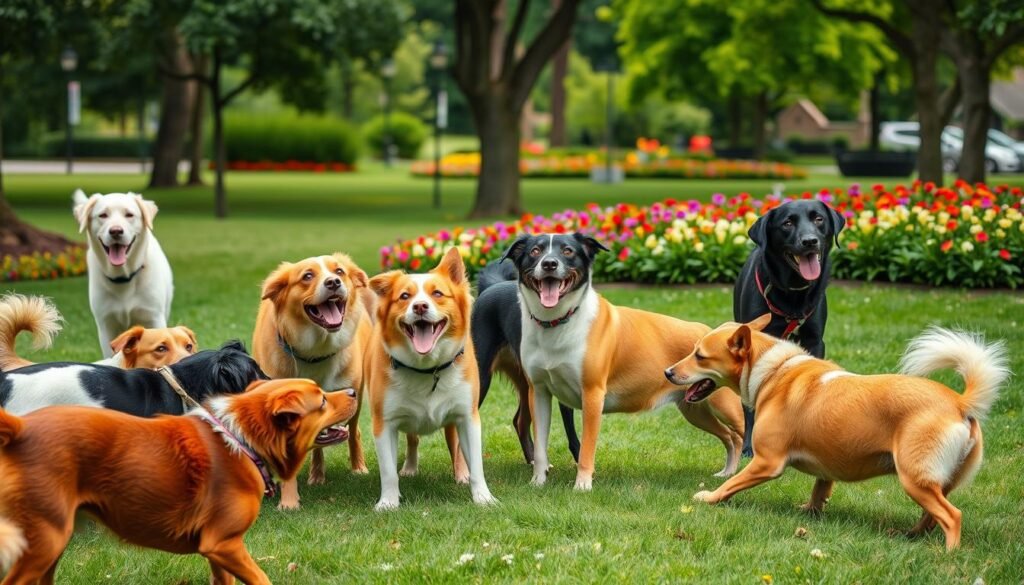
Reading Canine Body Language
It’s vital to understand dog body language for successful introductions11. I look for signs of stress, like raised hackles or growling. If I see these, I back off and slow down the introduction.
Some dogs might not want to meet new friends10. In that case, I respect their boundaries and don’t push them.
Managing Dog Park Interactions
Here’s how I follow dog park etiquette:
- Make sure my dog’s vaccinations are up-to-date
- Keep my dog on a leash until we’re in the off-leash area
- Watch interactions closely
- Step in if play gets too rough
- Clean up after my dog
For dogs that react on-leash, I skip standard introductions and get professional help12. Remember, meeting new dogs needs patience and careful watching for a good experience.
| Dog Interaction Tip | Benefit |
|---|---|
| Use neutral meeting grounds | Minimizes possible conflicts |
| Start with parallel walking | Allows a stress-free introduction |
| Positive reinforcement | Encourages good behavior |
| Seek professional advice when needed | Ensures safe introductions in tough situations |
By following these tips, you can help your dog make friends and feel confident in social situations11.
Environmental Desensitization Techniques
Environmental desensitization is key in dog training. It helps dogs feel more comfortable in new places. Let’s look at some ways to help dogs get used to new environments.
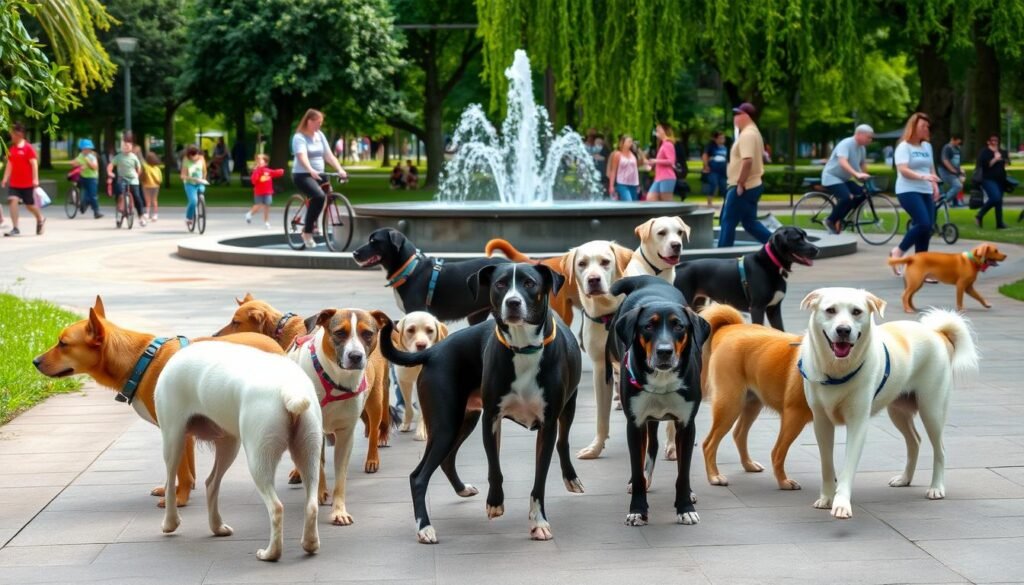
1. Start with calm places: Begin by taking your dog to quiet spots. As they get more comfortable, you can introduce more complex places. This method is called desensitization, where you slowly expose dogs to things that scare them13.
2. Use positive reinforcement: Reward your dog with treats and praise for new experiences. This is called counterconditioning, where you pair something scary with something positive13.
3. Let them walk on different surfaces: Let your dog walk on grass, pavement, and sand. This helps them feel confident in different places.
4. Start far away from triggers: When introducing your dog to new things, start from a distance. Then, you can move closer. This controlled method is important for desensitization13.
5. Break down big situations: If a place is too much, break it down into smaller parts. Start with the least scary parts first13.
| Environmental Factor | Desensitization Technique | Expected Outcome |
|---|---|---|
| New Surfaces | Gradual exposure to different textures | Increased confidence in walking |
| Loud Noises | Start with low volume, gradually increase | Reduced fear response to sounds |
| Busy Areas | Begin with less crowded spaces, progress slowly | Improved comfort in public settings |
Remember, desensitizing your dog takes time. It can take months, even years, for dogs with deep fears14. Be patient and keep up the good work for the best results.
Building Confidence Through Touch and Handling
Teaching your dog to enjoy handling is key for their well-being. Consistent touch and handling build trust. This makes grooming and vet visits smoother. Let’s explore some effective dog handling techniques to make your furry friend more comfortable with human touch.
Paw and Nail Handling
Start by gently touching your dog’s paws during calm moments. Gradually increase the touch and pressure, always with treats. This positive association helps prepare dogs for nail trims and paw checks. Remember, patience is key as some dogs may be initially sensitive to paw handling.
Grooming Preparation
Preparing dogs for grooming starts with regular brushing. Use a soft brush and start with short, gentle strokes. As your dog gets more comfortable, you can introduce different grooming tools. This gradual approach helps build trust and makes grooming sessions less stressful.
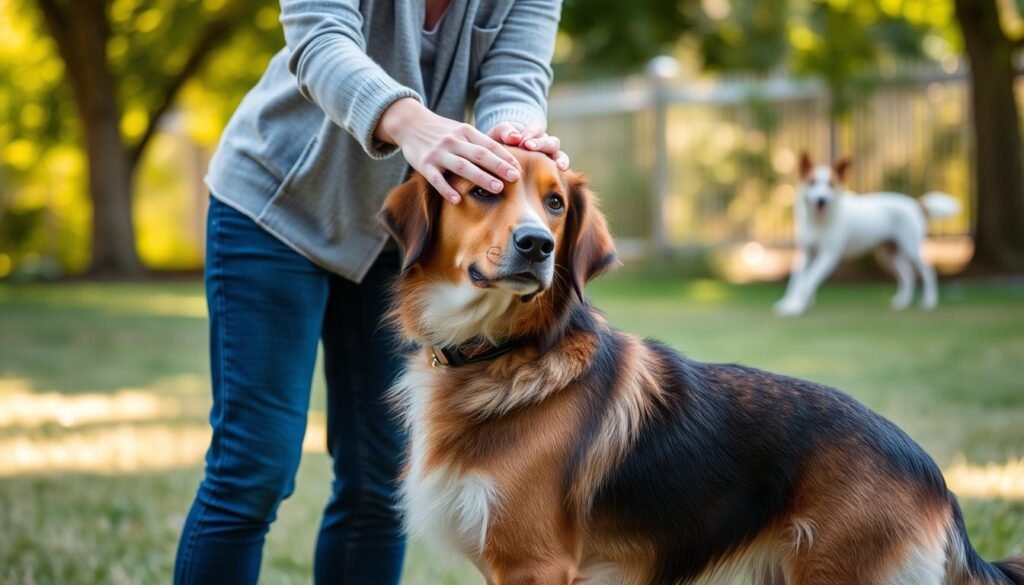
Veterinary Visit Preparation
To ease vet visits, practice examining your dog’s ears, teeth, and body at home. Use treats to create positive associations with these touches. It’s beneficial to have family members participate in these exercises. This accustoms your dog to different people touching them15.
| Handling Area | Technique | Benefit |
|---|---|---|
| Paws | Gentle touch, increasing pressure | Easier nail trims |
| Body | Regular brushing | Comfortable grooming sessions |
| Ears & Teeth | Brief examinations with treats | Smoother vet visits |
By consistently applying these dog handling techniques, you’re not only preparing your pet for grooming and vet visits. You’re also strengthening your bond. Remember, building confidence takes time, so celebrate small victories along the way!
Sound Sensitivity Training
Teaching your dog to be less sensitive to sounds is important. I’ll share tips on how to help your dog feel more at ease with loud noises. We’ll look at ways to help your dog feel better in different noise situations.
Indoor Noise Exposure
Begin with sounds you hear at home. I introduce my dog to sounds like vacuum cleaners and doorbells. I use treats to make these sounds positive for them. This method is called counter conditioning and takes about 2-3 months16.
Outdoor Sound Desensitization
Outdoor sounds can be tough for dogs. I expose my dog to traffic and construction noises, even thunder recordings. Many dogs are scared of loud noises17. I do these exercises every day for 8-12 weeks to see progress16.
Traffic and Urban Sounds
City sounds can be too much. I work on helping my dog get used to sirens and car horns. I make a quiet spot for them during loud times17. I use play or treats to keep them calm.
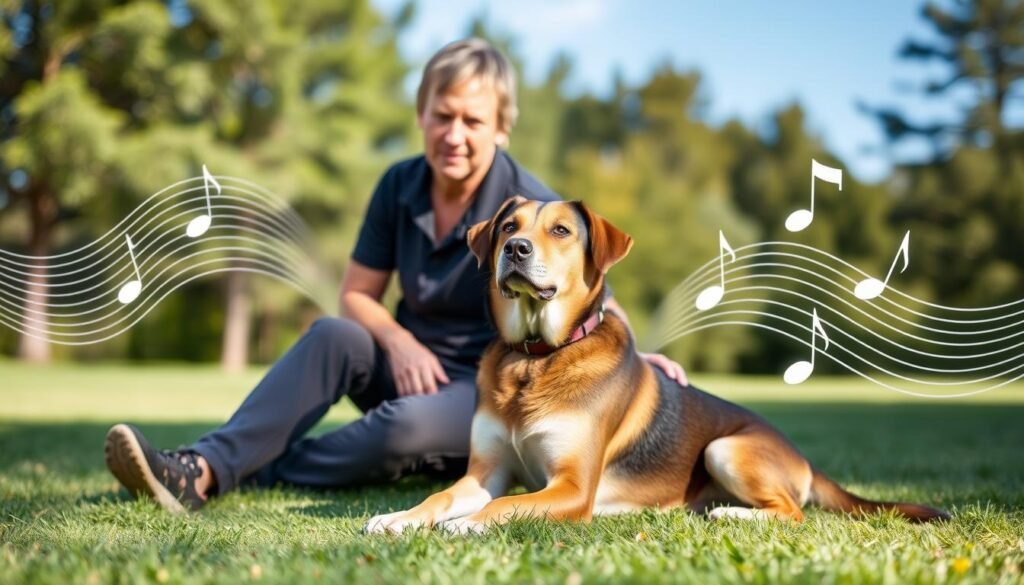
| Sound Type | Example | Training Duration |
|---|---|---|
| Indoor | Vacuum, Blender | 2-3 months |
| Outdoor | Traffic, Thunder | 8-12 weeks |
| Urban | Sirens, Car Horns | Ongoing |
Remember, getting your dog used to sounds takes time. Be patient and consistent. With the right training, your dog can feel more comfortable in noisy places.
Socialization in Different Environments
Exposing dogs to different places is vital for their social growth. The best time to start is between three and fourteen weeks. This is when they are most open to new things18.
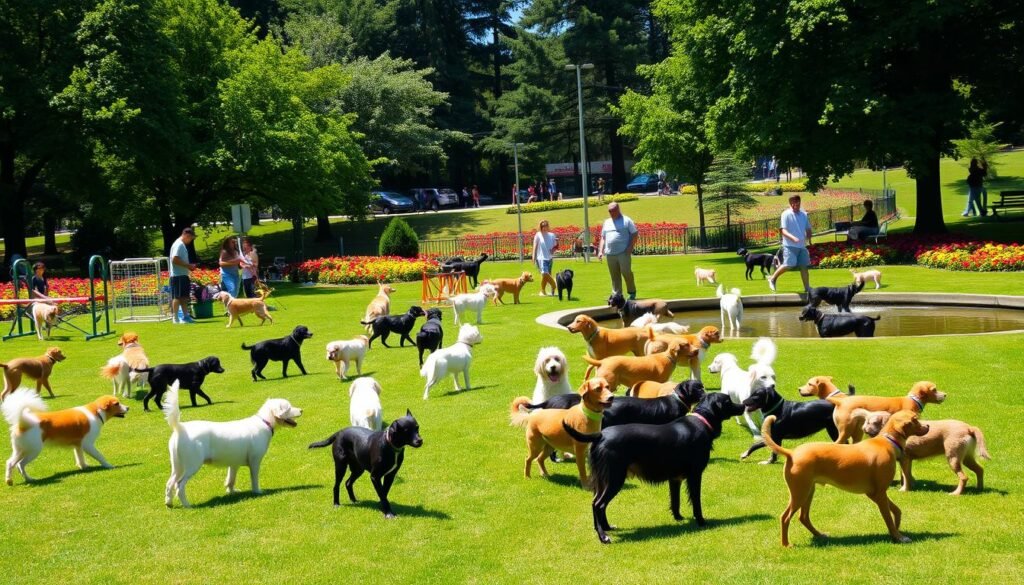
Introducing dogs to new places should be done slowly. I start with quiet areas and then move to busier ones. This helps them avoid feeling overwhelmed and builds their confidence.
In cities, I focus on getting dogs used to urban life. This includes busy streets, parks, and pet stores. The aim is to make these places positive for them.
Puppy classes are great for socializing dogs between 8-16 weeks. They are both effective and easy19. These classes offer a safe space for dogs to meet other puppies and people.
Even older dogs can benefit from regular social interactions. It’s important to keep introducing them to new things throughout their lives18. This can greatly improve their social skills and confidence.
Positive reinforcement is key for successful socialization. I use treats and praise to encourage good behavior in new situations18. This helps them develop positive associations with different environments.
Advanced Training and Behavioral Modification
Advanced dog training techniques can shape your pup’s behavior and enhance social skills. Let’s look at some effective methods for better obedience and social skills.
Positive Reinforcement Methods
Positive reinforcement is key in modern dog training. It rewards good behavior, encouraging it to happen again. Training should be short, lasting 5 to 10 minutes, several times a day. It should match your dog’s age, breed, and personality20.
Immediate rewards or praise after good behavior strengthens the bond between action and reward20.
Clicker Training Techniques
Clicker training is a favorite positive reinforcement method. The clicker’s sound marks the exact moment of the desired action. This clarity helps your dog learn faster and more effectively.
Reward-Based Systems
Reward-based training systems motivate dogs during training. Being consistent with these methods is key for success20. Socialization in a dog’s early months is also vital. It helps prevent fear, separation anxiety, and aggression20.
| Training Method | Benefits | Best For |
|---|---|---|
| Positive Reinforcement | Builds confidence, strengthens bond | All dogs, including sensitive ones |
| Clicker Training | Precise timing, clear communication | Dogs learning new skills |
| Reward-Based Systems | Increases motivation, reinforces good behavior | Food-motivated dogs |
For dogs with behavioral issues, a professional trainer is best. They can create a customized plan for your dog. Some dogs need ongoing training and management21. Regular socialization, like doggy daycares or playdates, helps your dog become well-rounded and sociable20.
Conclusion
Raising a well-socialized dog is a lifelong journey. It starts early and never ends. The first 14 weeks are key for socialization2223. But, you can keep socializing your dog at any age23.
Dogs that are well-socialized are happier and less likely to be aggressive or anxious2423. They also learn faster and behave better. Socializing your dog means giving them a happy, confident life.
Every dog is different. Some like quiet places, while others love busy spots22. Use positive methods and introduce new things slowly. Always keep your dog safe and comfortable24.
If your dog seems scared or aggressive, get help from a pro23. With patience, love, and consistency, you can raise a confident, happy dog. They’ll be ready to face the world with you.
FAQ
What is the critical socialization period for puppies?
Puppies are most open to new things between 8-16 weeks old. This is when they learn the most about the world. It’s key for their future behavior and confidence.
How many people should I aim to introduce my puppy to in the first month?
Try to introduce your puppy to about 400 people in the first month. This helps them get used to many different people.
How do I safely introduce my dog to other dogs?
Start with one-on-one meetings in a controlled setting. Make sure the other dogs are friendly and up-to-date on shots. Let them sniff each other during walks. Always watch their body language for positive interactions.
What’s the best way to expose my dog to different environments?
Begin with calm places and then move to more complex ones. Introduce them to different surfaces and weather. Use treats and praise to make new experiences positive.
How can I prepare my dog for grooming and vet visits?
Handle your dog’s ears, snout, teeth, paws, nails, body, and tail from the start. This gets them used to grooming and vet visits. Use treats and praise to make it positive.
How do I help my dog overcome fear of loud noises?
Start by exposing them to sounds in a controlled way. Use treats and praise to help them feel good about these sounds. Gradually increase the volume and time as they get more comfortable.
Is socialization only important for puppies?
Socialization is key for puppies, but it’s important for dogs of all ages. For older dogs, focus on overcoming fears and introducing them to new things in a positive way.
What training techniques work best for socialization?
Positive reinforcement is best for socialization. Use treats, toys, and praise. Clicker training can also help mark good behaviors during socialization.
How do I know if my dog is stressed during socialization?
Watch for signs of stress like a tucked tail, flattened ears, or whale eye. Also, look for excessive panting or trying to hide. If you see these signs, slow down and be more careful.
What should I do if my adult dog is poorly socialized?
For adult dogs, start slow and be patient. Begin with easy situations and gradually get harder. Consider a professional dog trainer or behaviorist for a plan tailored to your dog. Remember, it’s never too late to help your dog become more social!
Source Links
- How to Socialize a Dog: Expert Tips for a Confident Canine
- Puppy Socialisation and Fear Periods
- No title found
- The Importance of the Critical Socialization Period (Time You Will NEVER Get Back)
- The Complete Guide to Dog Socialization: Tips, Methods, and Challenges | Albany Off Leash K9 Dog Training
- Dog Socialization 101: The Complete Guide for Dog Parents
- How to Socialize an Adult Dog and Why It’s Never Too Late
- No title found
- How to Socialize a Dog
- How To Introduce Dogs to Each Other
- From Woofs to Wags | Expert Tips on How to Introduce Dogs Successfully – Snouts and Stouts
- How to Introduce Dogs to Each Other
- Overcoming Fears with Desensitization and Counterconditioning | VCA | VCA Animal Hospitals
- No title found
- Building Confidence in Dogs
- Paws N Play Dog Training
- Understanding and Managing Noise Phobia in Dogs – Rex Specs
- How to Socialize a Dog | University Veterinary Hospital
- 10 Essential Tips for Socializing Your Puppy (And What NOT to Do!) – DW Dog Training
- Five Top Tips for Successful Canine Behavior Training
- Will Socialization Help With Aggression?
- Socializing Your Dog: Tips & Tricks – A.R.F.-Animal Rescue Foundation
- The Importance of Socializing Your Dog: Tips and Strategies
- The Key to a Well-Adjusted Pet: Canine Socialization Tips
editor's pick
latest video
news via inbox
Nulla turp dis cursus. Integer liberos euismod pretium faucibua

